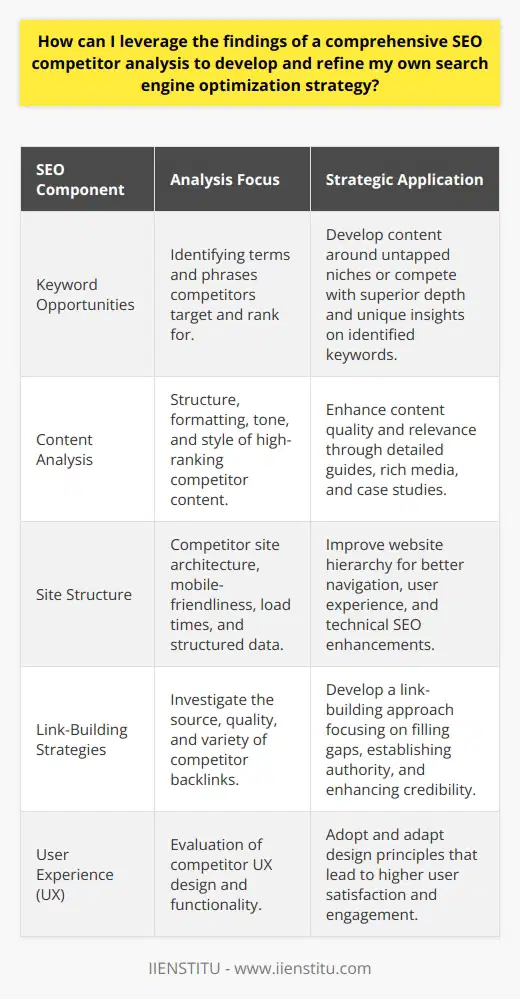
In the digital era, standing out among the crowd isn’t just about creating great products or services—it’s about ensuring your audience can find you. Search Engine Optimization (SEO) is the cornerstone of online visibility, and understanding your competitors' SEO strategies is vital to crafting your own. This article delves into five key strategies that can help you analyze competitors’ websites and build an SEO plan that drives results.
Introduction: Why Competitor SEO Analysis is Crucial
Competition is the heart of innovation. Whether you're running a small business or managing a large enterprise, knowing what your competitors are up to gives you a crucial advantage. Their SEO tactics can provide valuable insights into trends, customer behavior, and gaps in the market that you can leverage.
When I first started working on optimizing a website for a local business, I felt overwhelmed by the number of tools and strategies available. Instead of diving blindly, I turned to analyze competitors who were ranking well in the same niche. By understanding their strategies—keywords, backlinks, and content themes—I gained clarity and formulated an approach that doubled our organic traffic within six months.
Let’s explore five actionable strategies to gain insights into your competitors’ SEO tactics.
1. Analyzing Your Competitors’ Websites
The first step in SEO competitor analysis is diving into their websites. Here’s what you should focus on:
Keyword Focus: Look at the main keywords they are targeting. Tools like SEMrush or Ahrefs allow you to plug in a competitor’s domain and reveal the keywords they rank for. You might find some surprising terms that you hadn’t considered.
Content Structure: Examine how they organize their website. Is it easy to navigate? Do they have comprehensive landing pages for each product or service? If you notice recurring structures, like FAQs or customer testimonials, it’s worth considering for your site.
Meta Descriptions and Titles: Meta titles and descriptions are often overlooked but play a significant role in click-through rates. See how your competitors craft theirs—are they clear, compelling, and keyword-rich?
When I analyzed a competitor's website in the tech industry, I noticed they had a unique section highlighting "case studies." This wasn’t something I had considered, but I realized it established authority. Adding a similar feature to our site improved not only engagement but also rankings.
2. Investigating Keywords and Phrases
Once you’ve identified your competitors’ key content pillars, dive deeper into keyword research. Keywords are the lifeblood of SEO, and analyzing your competitors' choices can uncover valuable opportunities.
Tools for Keyword Analysis
Google Keyword Planner: Free and straightforward, this tool allows you to see search volumes and related keywords.
Google Trends: This helps you understand whether a keyword is gaining or losing popularity over time.
AnswerThePublic: A unique tool that shows common questions and phrases related to a keyword.
Steps to Investigate Keywords
Focus on Primary Keywords: Identify the main terms competitors rank for and evaluate their relevance to your business.
Discover Secondary Keywords: Competitors often rank for secondary terms that drive significant traffic. Add these to your strategy to capture untapped audiences.
Spot Long-Tail Opportunities: Long-tail keywords, like "best vegan protein powder for athletes," have less competition and higher conversion rates.
Pro Tip: Try creating clusters around your main keyword. For example, if your primary keyword is “fitness tips,” related clusters could include “fitness tips for beginners” or “advanced fitness tips for weight loss.”
3. Identifying Trends in Your Industry
Industries evolve constantly, and staying ahead requires recognizing patterns before they become mainstream. Studying your competitors’ content can reveal emerging trends.
What to Look For:
Popular Blog Topics: See what topics competitors are writing about frequently. Are they emphasizing sustainability, new technology, or consumer health?
Seasonal Campaigns: Some industries experience periodic spikes in interest. For instance, fitness brands might ramp up around New Year’s resolutions or summer.
Media Coverage: Analyze how your competitors are portrayed in the media. Are they launching new initiatives that are gaining traction?
My Personal Take:
When working on a fashion e-commerce site, I noticed our competitors began incorporating AI tools to help customers find their size. Recognizing this trend early allowed us to implement similar functionality, which led to increased user satisfaction and sales.
4. Examining Other SEO Strategies
Beyond keywords and content, there are several other SEO tactics your competitors might be using:
Backlinks
Backlinks are one of the strongest ranking factors for SEO. Use tools like Moz Link Explorer or Ahrefs to:
Identify websites linking to your competitors.
Determine the quality of those links. Are they coming from reputable sources?
Find potential link-building opportunities for your site.
For example, if your competitor is consistently featured in industry blogs, reach out to those blogs with your own unique pitch.
Social Media Campaigns
SEO isn’t isolated from social media. Study how your competitors leverage platforms like Instagram or LinkedIn to drive traffic:
Are they using hashtags strategically?
How often do they promote blog posts or products on social media?
Are there any viral campaigns or creative strategies worth emulating?
Website Design and Technical SEO
Is their website mobile-friendly?
Do they load pages quickly?
Are they using structured data to create rich snippets in search results?
I remember once stumbling upon a competitor’s lightning-fast mobile site. By implementing a similar mobile optimization strategy, we improved our rankings and kept users on our site longer.
5. Looking for Backlinks and Social Media Campaigns
Social proof, as demonstrated by backlinks and social media mentions, is integral to SEO. By analyzing your competitors’ presence here, you can uncover untapped opportunities:
Backlink Strategies
Competitor Benchmarking: Use tools like Ahrefs to see the total backlinks competitors have and what domains they come from.
Guest Posting Opportunities: Many backlinks come from guest posts on high-authority sites. Identify these opportunities and pitch your own ideas.
Broken Link Building: Check for broken links on websites linking to competitors and suggest your site as a replacement.
Social Media Alignment
While social media doesn’t directly affect rankings, it drives traffic. Observe:
Content that gets the most likes, shares, or comments.
Types of posts driving users to their blogs (e.g., infographics, videos).
Use of influencers or partnerships.
Taking Action on Competitive Insights
By analyzing your competitors' websites, keywords, and other SEO strategies, you can gather actionable insights to improve your digital presence. SEO isn’t a static field—it’s constantly changing, and learning from others helps you adapt.
As I’ve learned in my journey, competitive analysis is not about copying but about innovating on proven strategies. Start with these steps, customize them to your business, and watch your SEO results improve.
Know your competitors to understand your SEO strategy.
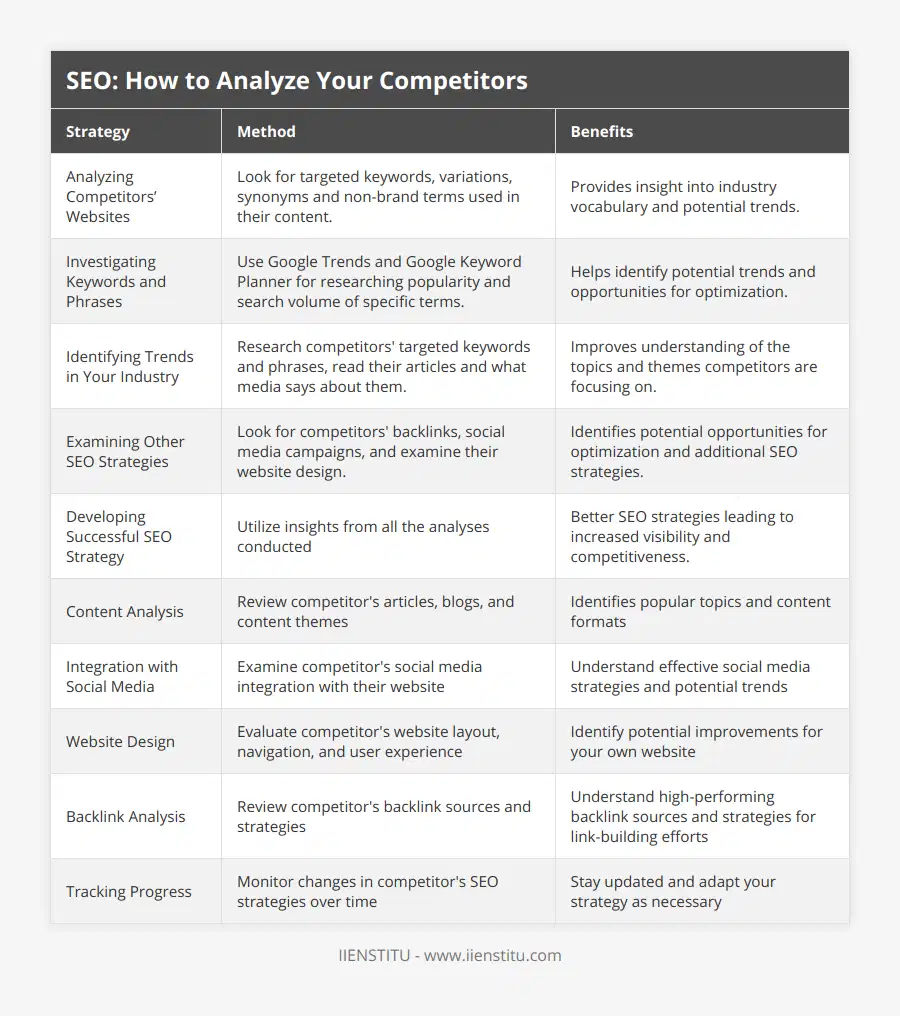
References
Chaffey, D. (2021). Digital Marketing Strategy. Pearson.
Fishkin, R. (2018). Lost and Founder. Penguin Random House.
Frequently Asked Questions
What are the best ways to analyze my competitors' SEO strategies?
When attempting to gain an edge over the competition, it is essential to analyze their SEO strategies. SEO, or search engine optimization, is optimizing a website to increase its visibility in search engine results. By studying the SEO strategies of competitors, one can gain valuable insight into how to improve their website's ranking.
One of the best ways to analyze a competitor's SEO strategy is to review their website. Examining the website's structure, content, and use of keywords can provide a good indication of the competitor's SEO strategy. Additionally, reading the backlinks that link to the competitor's website can give insight into how they gain visibility in search engine results.
Analyzing the website performance of a competitor can also be a valuable tool in determining how successful their SEO strategy is. Examining the website’s traffic, bounce rate, and conversion rate can indicate the effectiveness of its SEO strategy. Additionally, looking at the number of organic visits and the average time spent on the website can also provide insight into how well the website is performing.
Finally, analyzing the competitor's use of social media can provide valuable information about their SEO strategies. Examining the number of followers, likes, and shares can indicate how well the website is being promoted on social media. Additionally, looking at the engagement levels and the type of content being shared can provide insight into which strategies are working and which are not.
In conclusion, analyzing a competitor's SEO strategies can provide valuable insight into how to optimize one's website best. Examining the website structure, content, and backlinks can provide information about the competitor's SEO strategy. Additionally, looking at the website performance and the competitor's use of social media can provide further insights into their SEO strategies.
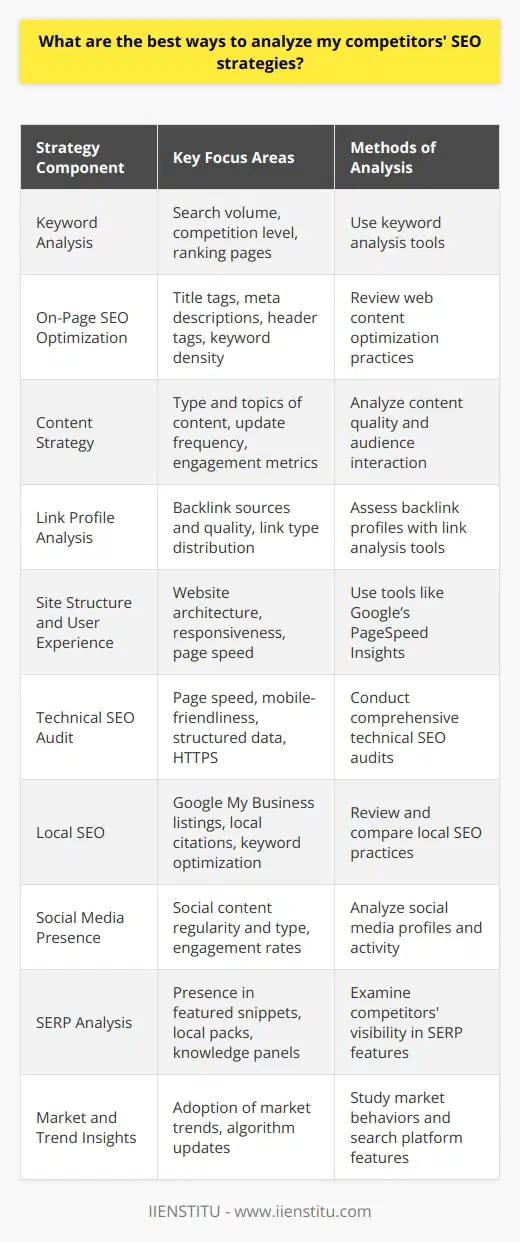
How can I identify trends in my industry related to SEO?
Search engine optimization (SEO) is one of the most powerful tools for improving the visibility of a website in search engine results. As such, it is essential for businesses to stay abreast of trending SEO-related topics in their industry. This article will discuss the various methods of identifying trends related to SEO to keep a business' website up-to-date and competitive.
The first method of identifying trends related to SEO is through research. Businesses should regularly review industry publications, websites, and blogs to stay informed of new developments in SEO. Additionally, companies should review their competitors' websites to identify any new techniques or strategies they may employ. This can provide valuable insight into techniques that may improve a website's rankings.
Another method of identifying trends related to SEO is to consult with an SEO expert. SEO experts have the knowledge and experience to identify changes in search engine algorithms and trends in SEO techniques. They can also provide guidance and advice on how to implement SEO strategies for a particular industry best.
Finally, businesses should take advantage of online tools to monitor SEO trends. There are various online tools available that can track changes in search engine algorithms, as well as identify popular keywords and phrases related to a particular industry. Using these tools, businesses can stay ahead of the curve and ensure that their websites are optimized for the most relevant keywords and phrases.
In conclusion, businesses must stay abreast of trends related to SEO to remain competitive in their industry. Researching industry publications and blogs, consulting with an SEO expert, and taking advantage of online tools can help identify SEO trends. By following these methods, businesses can ensure that their website is optimized for the most relevant keywords and phrases and remain competitive in their industry.
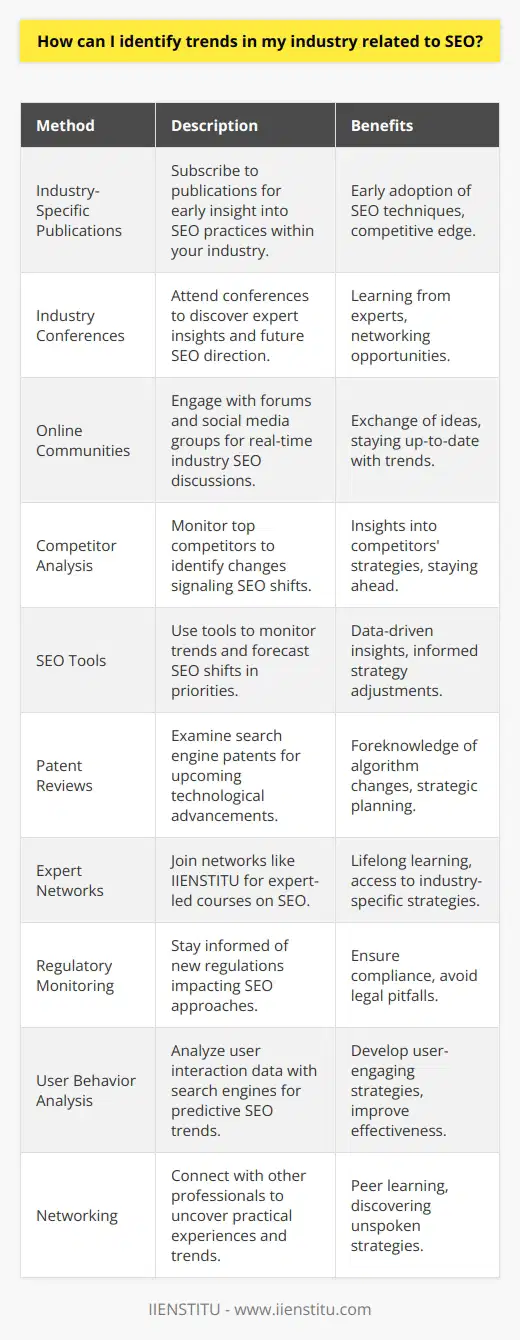
What keywords and phrases should I be targeting to improve my SEO?
Search engine optimization (SEO) is an essential component of any successful digital marketing strategy. To maximize the visibility of a website or blog in the search engine results pages (SERPs), one must consider the use of effective keywords and phrases. In this article, we discuss the importance of keyword and phrase selection, as well as providing guidance on how to identify the most relevant terms for SEO.
When creating content for a website or blog, it is essential to consider the use of keywords and phrases that are relevant to the topic and that will be used by potential readers to find the content. Relevant keywords and phrases should be selected in order to optimize content for the targeted audience and to improve the chances of the content appearing in the SERPs.
When selecting keywords and phrases, one should consider the context in which the content will be used. For example, if the content is intended to be used as a blog post, then the keywords and phrases should reflect the topics that readers may be interested in. Additionally, one should consider the search engine algorithms and the terms that are likely to be used by readers to find the content.
One should also consider the use of specific phrases and words that will be used in the content. For example, if one is writing a blog post about the benefits of exercise, then the keywords and phrases might include “exercise benefits”, “physical activity”, and “fitness”. Additionally, one should consider the use of synonyms and related terms that may be used by readers to find the content.
When selecting keywords and phrases, one should also consider the competition for the terms. One should identify the competitors, their content, and the terms they are targeting. This will allow one to determine which terms are the most effective and relevant for the content. Additionally, one should consider the use of long-tail keywords and phrases, which are phrases that are more specific and contain more than one word.
Finally, one should consider the use of meta tags and descriptions. Meta tags and descriptions are important components of SEO, as they can help improve the visibility of a website or blog in the SERPs. Additionally, meta tags and descriptions should be optimized with relevant keywords and phrases in order to maximize the visibility of the content.
In conclusion, the selection of keywords and phrases is an essential component of SEO. When selecting keywords and phrases, one should consider the context in which the content will be used, the search engine algorithms, the terms that are likely to be used by readers to find the content, the competition for the terms, and the use of meta tags and descriptions. Following these steps will ensure that the content is optimized for the targeted audience and that it has the best chance of appearing in the SERPs.
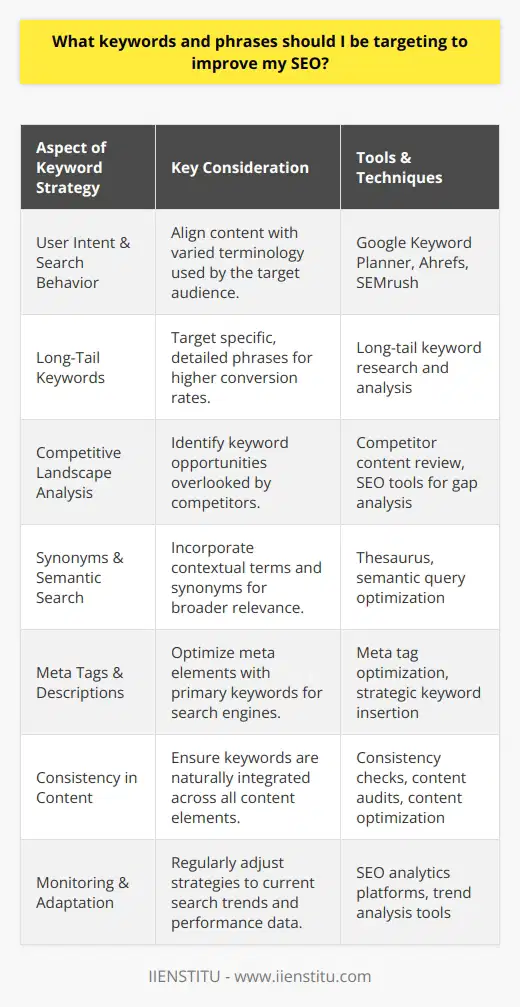
How do you assess the effectiveness of competitor backlink profiles?
**Analyzing Competitor Backlinks**
To assess the effectiveness of competitor backlink profiles, it is essential to perform a thorough analysis of their backlinks. There are several factors to consider when evaluating the effectiveness of backlinks:
**Relevance of Backlinks**
The relevance of backlinks is vital in determining their effectiveness. Assess the topical relevance of the websites linking to your competitors by analyzing the content of these sites. Backlinks from websites with a similar niche or those that share contextual similarities are more valuable.
**Authority of Referring Domains**
The authority of the websites linking to your competitors impacts the effectiveness of their backlink profiles. Websites with higher domain authority tend to transfer more link equity. Utilize tools to gauge the domain authority of referring websites, such as Moz's Domain Authority or Ahrefs' Domain Rating.
**Anchor Text Distribution**
Analyze the distribution of anchor texts in your competitor's backlink profile. This assessment helps identify the common and targeted keywords. A well-balanced distribution of anchor texts, including branded, generic, and keyword-rich variants, suggests a more effective backlink profile.
**Number and Quality of Backlinks**
The number of backlinks can be a significant factor in assessing the effectiveness of a competitor's backlink profile. However, prioritize the quality over quantity. High-quality backlinks from authoritative and relevant websites contribute more to the effectiveness of a backlink profile than numerous low-quality links.
**Link Placement**
Evaluate the placement of the backlinks on the referring websites. Links placed within the main content, such as embedded within text or near the beginning of articles, tend to carry more weight. Contrastingly, backlinks in footers or sidebars tend to be less valuable.
**Link Velocity**
Consider the rate at which your competitors are acquiring backlinks, known as link velocity. A consistent and steady pace of acquiring high-quality links indicates an effective backlink profile. On the other hand, a sudden spike in low-quality links suggests potentially harmful practices, such as link spamming.
**Competitor Backlink Gap Analysis**
Lastly, conduct a backlink gap analysis by comparing your own backlink profile with those of your competitors. This comparison identifies potential opportunities to acquire valuable backlinks from websites that are not yet linking to your site but are linking to your competitors.
In conclusion, assessing the effectiveness of competitor backlink profiles requires a comprehensive analysis that takes into account multiple factors. By closely examining the relevance, authority, anchor text distribution, number and quality, link placement, and link velocity, one can identify strengths and weaknesses in competitors' backlink strategies and make informed decisions about improving their own backlink profiles.
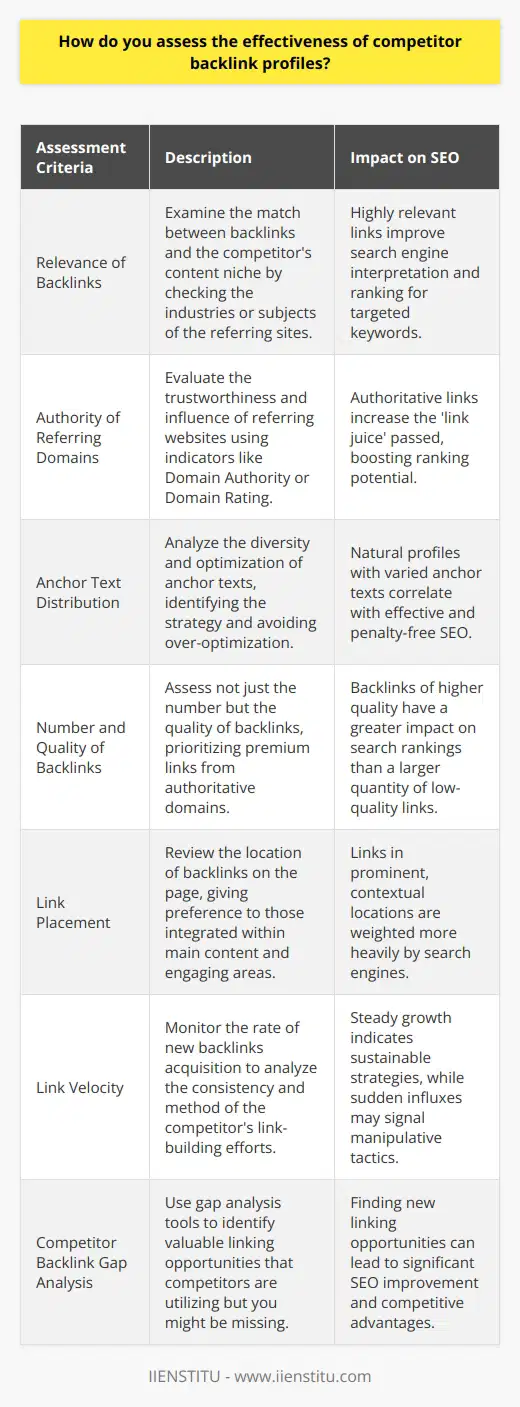
What methods can be employed to gather insights on competitors' website traffic and user behavior?
Methods for Gaining Insights on Competitors' Website Traffic
Quantitative Data Collection
One effective method is to collect quantitative data through online tools such as Alexa, SimilarWeb, or SEMrush. These platforms offer valuable insights, such as visitors' geographical distribution, traffic sources, and the most popular content on a competitor's website. This information can guide strategies for capturing a broader audience and improving website performance.
Social Media Analysis
Analyzing the social media activity of competitors can provide insights into their target audience's preferences and engagement levels. Examining the content they post, the frequency of posting, and the interactions on their posts can help identify patterns that contribute to the competitor's online presence, allowing for benchmarking and informed strategic decisions.
Online Reviews and Feedback
Another effective method involves analyzing customer reviews, blog comments, and forum discussions to understand the user experience with a competitor's website. This qualitative data can reveal the competitor's strengths and weaknesses, which can be used to design better strategies for attracting and retaining users. For example, if negative feedback is frequently given about poor website navigation, it provides an opportunity to focus on enhancing the user experience on their website.
Audience Overlap Analysis
Audience overlap analysis is a technique that reveals the extent to which a competitor's audience matches the target audience of the observer. Tools like Alexa offer audience overlap scores that allow for understanding of competitors' reach and relevance to the target audience. This method enables comparisons and evaluation of similarities in website traffic, allowing marketers to identify potential strategies for capturing a similar audience.
Backlink Analysis
Backlinks, or inbound links from other websites, can provide insights into a competitor's online reputation and authority. Analyzing the number and quality of websites linking to a competitor can shed light on their content marketing strategies and partnership efforts. High-quality backlinks indicate that a website has valuable information which other websites want to share, and replicating similar content strategies can help to improve one's own website authority.
In conclusion, several methods are available to gather insights on competitors' website traffic and user behavior. Analyzing quantitative and qualitative data, conducting social media analysis, exploring audience overlaps, and backlink analysis can unveil valuable information about competitors, allowing for the development of well-informed digital marketing strategies.
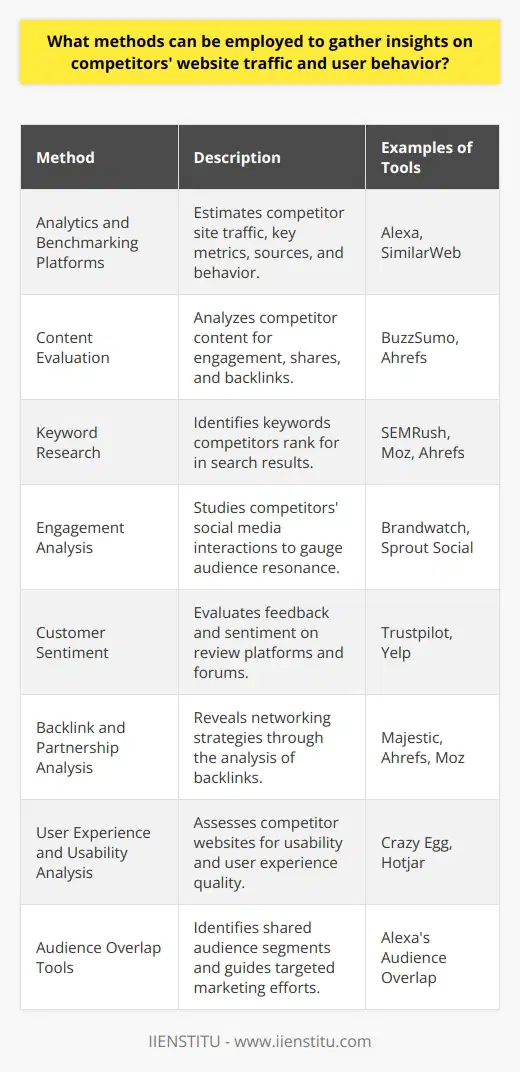
How can I gain an understanding of my competitors' content strategies and use that information to inform my own approach?
Analyzing Competitor Content
To gain an understanding of competitors' content strategies and use that information to develop an informed approach, consider these methods:
Keyword Research
Identify relevant keywords to your niche through tools like Google Keyword Planner or SEMrush. Determine the most popular keywords used by your competitors, and strive to either target these keywords or find related, less competitive phrases.
Content Audit
Perform a content audit by examining existing articles, blogs and other media published by competitors. Take note of content length, format, tone, and the frequency of posting. Assessing this information can shed light on their priorities and target audience, as well as reveal content gaps that you can fill.
Backlink Analysis
Investigate which websites link back to your competitors' content, using tools like Ahrefs or Moz. This will provide insights into the quality and relevance of their backlinks, and reveal potential partnership opportunities for your own blog.
Social Media Engagement
Monitor competitor social media channels to identify the types of content that resonate with their audience. Analyzing engagement metrics such as likes, shares, and comments can help tailor your content to attract similar reactions from your target audience.
Content Performance Metrics
Measure the success of your competitors' content through various performance metrics, such as overall pageviews, average time on page, and bounce rate. Tools like Google Analytics can provide rich insights and help identify which types of content yield the best results in your niche.
Competitor Strengths and Weaknesses
Finally, after analyzing your competitors' content strategies, identify their strengths and weaknesses. Aim to emulate successful elements while addressing any observed deficiencies in your own content approach. This may involve adopting alternative perspectives, exploring new topics, or simply improving on your competitors' execution in terms of writing style, structure or visual elements.
By conducting thorough research and analysis of competitors' content strategies, you foster an understanding of industry trends and preferences. This crucial information empowers you to make informed decisions when crafting and executing a comprehensive and competitive content strategy for your own blog.
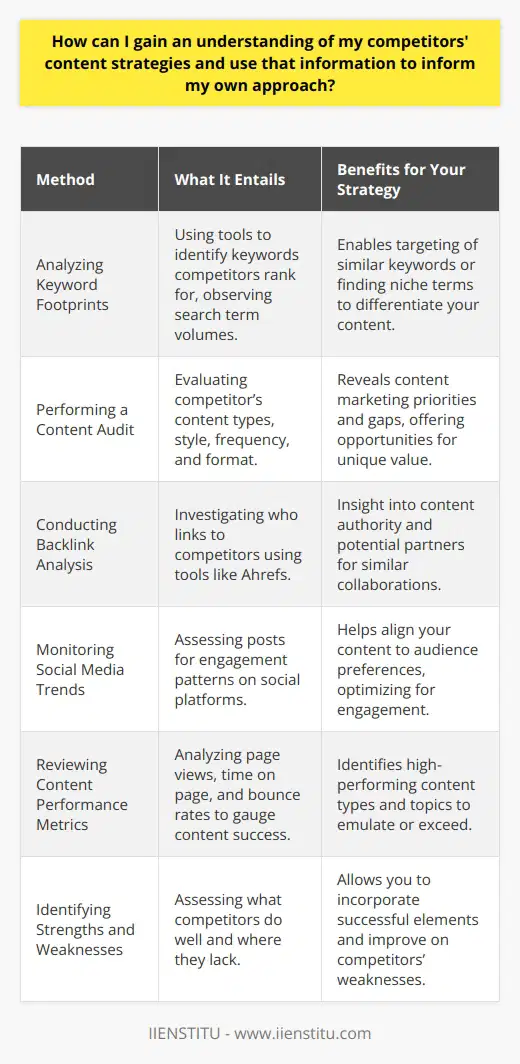
How do you evaluate the effectiveness of a competitor's keyword strategy in comparison to your own?
Analyzing Competitor's Keyword Strategy
To evaluate the effectiveness of a competitor's keyword strategy in comparison to your own, one can start by conducting a thorough analysis of the keywords used by both parties. This involves identifying their targeted keywords and assessing the rationale behind their choices.
Keyword Overlap and Gaps
First, analyze the keyword overlap by determining the common terms pursued by both businesses. This will give an insight into the shared competitive landscape. Additionally, identify any keyword gaps – terms targeted by one party but not the other. These gaps can reveal potential opportunities for expanding your keyword strategy.
Relevance and Search Volume
Next, assess the relevance and search volume of the targeted keywords. The relevance refers to how closely related the keywords are to the business goals and target audience needs. High search volumes indicate greater search interest, leading to potentially higher traffic. Comparing these two factors for both companies' keyword strategies helps to determine the effectiveness of their respective approaches.
Keyword Difficulty
Consider the keyword difficulty, which signifies the level of competition in ranking for specific terms. By comparing the difficulty level of keywords targeted by both businesses, one can gauge the feasibility of achieving higher rankings in search results. Ideally, an effective keyword strategy should strike a balance between targeting high-volume, relevant terms and maintaining a manageable competition level.
Current Rankings and Progress
Analyze the current rankings for the targeted keywords of both businesses using search engine results pages (SERPs). A higher ranking signifies better visibility and potentially more traffic. Comparing the rankings can provide insights into the short-term effectiveness of each keyword strategy. Furthermore, monitor the progress by regularly tracking changes in rankings over time, which offers a more comprehensive view of the long-term effectiveness.
Conversion Rates and ROI
Lastly, evaluate the conversion rates and return on investment (ROI) for the targeted keywords. This data indicates the extent to which the keyword strategy ultimately contributes to achieving business objectives. Comparing conversion rates and ROI between the competing strategies will help to identify and assess the most effective approach.
In conclusion, evaluating the effectiveness of a competitor's keyword strategy requires a multi-faceted analysis that considers various aspects such as keyword overlap, relevance, search volume, difficulty, rankings, and crucially, conversion rates and ROI. By conducting this thorough comparison, businesses can identify areas of improvement in their keyword strategy and make informed decisions to optimize their online presence.

What are the key metrics to consider when analyzing the performance of competitors' websites?
Understanding Competitors' Website Performance
Introduction
Analyzing the performance of competitors' websites plays a significant role in forming a successful digital marketing strategy. This involves evaluating several key metrics in various areas.
Traffic Metrics
One of the main indicators of a website's success is its traffic. Thus, it is essential to analyze competitors' websites in terms of the number of unique visitors, pageviews, and the sources of their traffic, such as organic search, referrals, social media, or email campaigns. This information can help you identify effective strategies for driving traffic to your own website.
Engagement Metrics
Analyzing user engagement on competitors' websites can give insight into their content effectiveness, site structure, and other factors driving user satisfaction. Key engagement metrics include the average time spent on the site, bounce rate, pages per session, and average session duration. It's essential to evaluate these metrics while considering the overall goal of competing websites, as different goals could require varying levels of user engagement.
Conversion Metrics
It's crucial to examine how effective competitors' websites are at converting visitors into desired actions. This can include filling out contact forms, newsletter sign-ups, or making purchases. Analyzing the conversion rate, the number of completed goals, and the specific paths users take to complete these actions can help you identify ways to optimize your site for conversions.
Usability Metrics
A website's usability directly affects its performance, as poor usability can lead to poor engagement. Analyzing competitors' websites for loading time, mobile-friendliness, navigation clarity, and ease of use can offer valuable insights for improving your own website's user experience.
Search Engine Performance Metrics
A website's visibility in search engines like Google can significantly influence its traffic and conversions. Analyzing competitors' search engine rankings for specific keywords, their backlink profile, and other search engine optimization (SEO) factors can help you determine what improvements to make in your website's SEO strategy.
Social Media Metrics
Determining the social media presence and performance of competing websites is useful in identifying content that resonates with your target audience. Analyze the number of followers, engagement rates, and the type of content shared on their social media platforms to understand the topics and formats that appeal to your audience.
Conclusion
Ultimately, analyzing the performance of competitors' websites using these key metrics can provide valuable insights for adjusting your own digital marketing strategy. It allows you to identify areas where improvements are necessary and spot the best practices to emulate. This can lead to increased success in terms of traffic, engagement, and conversions for your own website.
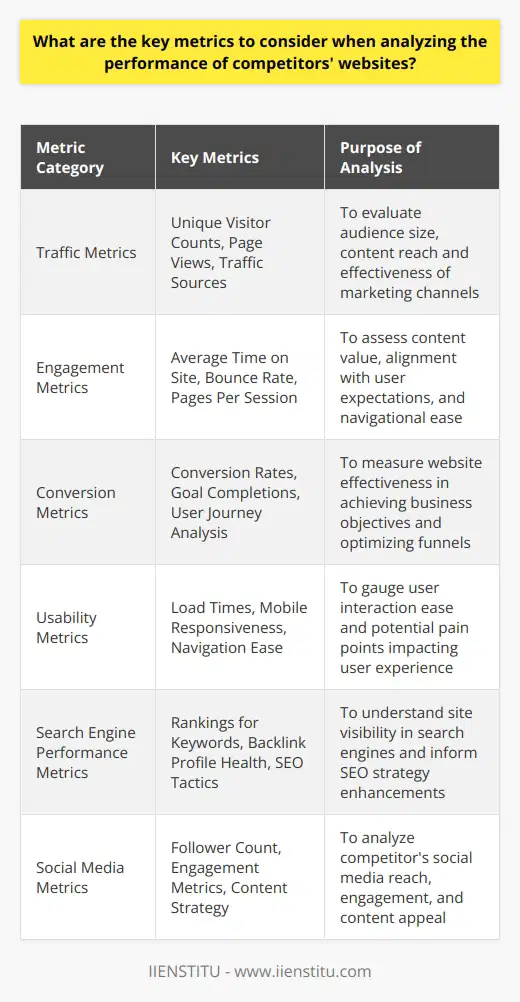
How can you identify potential opportunities or gaps in the market after analyzing your competitors' online presence?
Analyzing Competitor Strategies
To identify potential opportunities or gaps in the market after analyzing competitors' online presence, one should start by assessing their marketing strategies. The analysis includes examining their website layout, user experience, content quality, search engine optimization, social media activity, and paid advertising campaigns. These elements, when evaluated together, can provide valuable insights into the competitive landscape and potential areas for growth.
Understanding Target Audience
Further, understanding the target audience is essential when identifying gaps in the market. Analyzing the demographic, geographic, and psychographic profile of the competitors' target audience can help determine if there are underserved segments in need of specialized products, services or content. This information, combined with an understanding of the competitors' strengths and weaknesses, presents a clear view of areas where new market opportunities may exist.
Monitoring Keyword Performance
An essential part of analyzing competitors' online presence is monitoring their keyword performance. By identifying the search terms competitors are targeting and the keywords they rank highly for, businesses can uncover potential areas that are overlooked or not adequately addressed in the market. Companies can capitalize on these findings by targeting these keywords through search engine optimization, content creation, and digital advertising campaigns to enhance visibility and attract a larger audience.
Assessing Online Reviews and Feedback
A comprehensive analysis of competitors' online presence should also involve examining customer reviews and feedback on various platforms, such as social media, online forums, and review websites. By identifying recurring pain points or unmet needs expressed by customers, businesses can pinpoint potentially untapped market opportunities. Further, addressing these specific issues can result in improved customer satisfaction and a competitive edge.
Exploring Regional and Cultural Variations
Lastly, exploring regional and cultural variations in competing businesses can uncover potential market gaps. For instance, a business might find that particular services, products, or content is in demand in one geographic region but comparatively undersupplied or not available in another. By expanding their offerings to accommodate these variations, businesses can effectively differentiate their online presence and capture untapped market segments.
By comprehensively analyzing competitors' online presence and understanding their target audience, keyword performance, customer feedback, and regional and cultural variations, businesses can effectively identify potential opportunities or gaps in the market. These insights can then be used to develop targeted strategies aimed at capturing unexplored segments and gaining a competitive advantage.
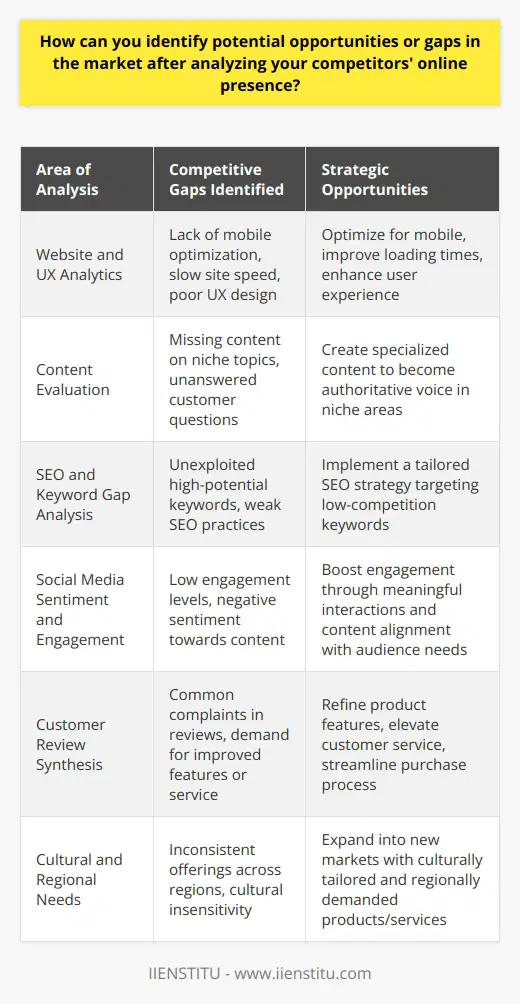
How do you determine the strengths and weaknesses of your competitors' website design and user experience?
Evaluating Competitors' Website Design
To determine the strengths and weaknesses of competitors' website design and user experience, it's essential to conduct a comprehensive competitive analysis. This process involves several steps: identifying competitors, analyzing their website content, layout, and navigation, and evaluating their overall user experience.
Identifying Competitors
Start by compiling a list of both direct and indirect rivals based on the target audience, geographical location, and product or service offerings. Once the competitors are listed, prioritize them based on their online presence, market share, and relevancy to your own business.
Analyzing Website Content
Focus on evaluating the quality, relevance, and comprehensibility of the written content on competitors' websites. Check for well-organized information, engaging visuals, proper headlining hierarchy, and the presence of a compelling call-to-action. Assess whether their content strategies cater to their target audience and whether it addresses user needs and pain points.
Examining Layout and Navigation
Analyze their website layout by determining the visual appeal, ease of navigation, and accessibility. Strong competitors will have a clear and logical hierarchy in their design, with simple navigation menus and a responsive layout for different devices. On the other hand, weaknesses may include cluttered layouts, broken links, or outdated designs that don't fit current web design standards.
Evaluating User Experience
User experience (UX) plays a crucial role in website performance, and it can be assessed by observing website usability, loading speed, mobile-friendliness, and the overall ease of use for visitors. A strong UX focuses on addressing user needs while keeping the experience enjoyable and efficient. Weaknesses in UX can lead to high bounce rates and poor conversions.
Utilizing Web Analytics Tools
Leverage web analytics tools like Google Analytics, SEMrush, or Hotjar to gain insights into competitors' website performance, traffic sources, and user behavior. These tools offer valuable data regarding the popularity, user engagement, and cost of acquisition for competitors, providing context to their strengths and weaknesses in design and UX.
In conclusion, determining the strengths and weaknesses of competitors' website design and user experience involves a systematic approach that includes competitor identification, content analysis, layout and navigation examination, user experience evaluation, and using web analytics tools. This thorough assessment allows businesses to gain a comprehensive understanding of their competitors' digital presence and identify areas of improvement for their own website.
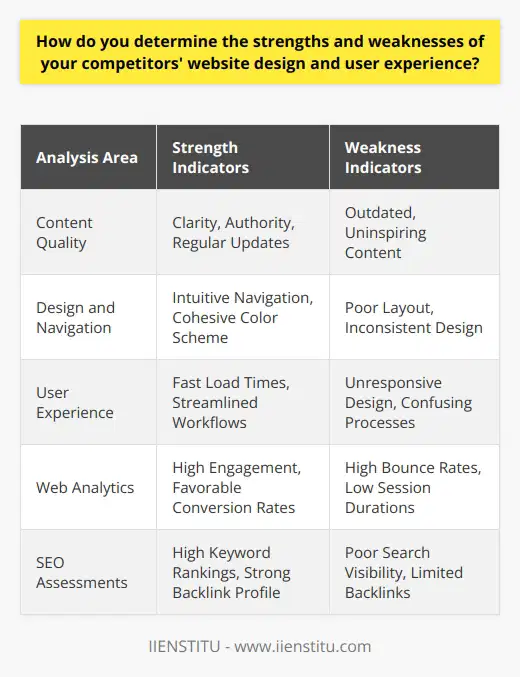
What techniques can be employed to analyze the social media presence and engagement of your competitors?
Identifying Competitors' Techniques
To analyze the social media presence and engagement of competitors, several techniques can be employed. These methods scrutinize the competitors' content, followers, and interactions to provide valuable insights into their digital strategies.
Social Media Audit
The first step involves conducting a social media audit for each competitor. This process analyzes the strengths and weaknesses of their communication strategies on platforms like Facebook, Twitter, Instagram, and LinkedIn. By evaluating their social media profiles and reviewing their content, one can identify the frequency and types of posts that resonate with their target audience.
Monitoring Engagement Metrics
Monitoring engagement metrics such as likes, comments, shares, and retweets allows one to assess how well a competitor's content is resonating with their followers. These indicators can illuminate techniques that drive higher levels of user interaction, and provide insights into the creation of an effective social media calendar.
Follower Analysis
Delving deeper into a competitor's follower demographics can reveal vital information about their target audience. Tools such as Facebook's Audience Insight and Followerwonk on Twitter can help analyze age, gender, interests, and location data. Comprehending patterns within these demographics can help in optimizing content strategies to reach the desired audience more effectively.
Content Analysis
A significant aspect of competitor analysis is assessing the content posted on their social media pages. Observing the tone, style, visual components, hashtags, and keywords can provide a blueprint for curating content that generates interest and fosters meaningful relationships with the desired audience. Popular tools to perform content analysis include Buzzsumo and Socialbakers.
Sentiment Analysis
Sentiment analysis considers the emotions and opinions expressed by followers in their interactions with a competitor's content. By discerning positive, negative, and neutral opinions, one can infer the effectiveness of various communication techniques in eliciting desired emotions and, consequently, shaping consumer behavior. Tools like Brandwatch and Sprout Social offer robust sentiment analysis solutions.
In conclusion, scrutinizing the social media presence and engagement of competitors can offer valuable insights into various aspects of digital strategy. Developing an understanding of their content, followers, and interactions can help in refining communication tactics, optimizing content creation, and fostering better relationships with target audiences.
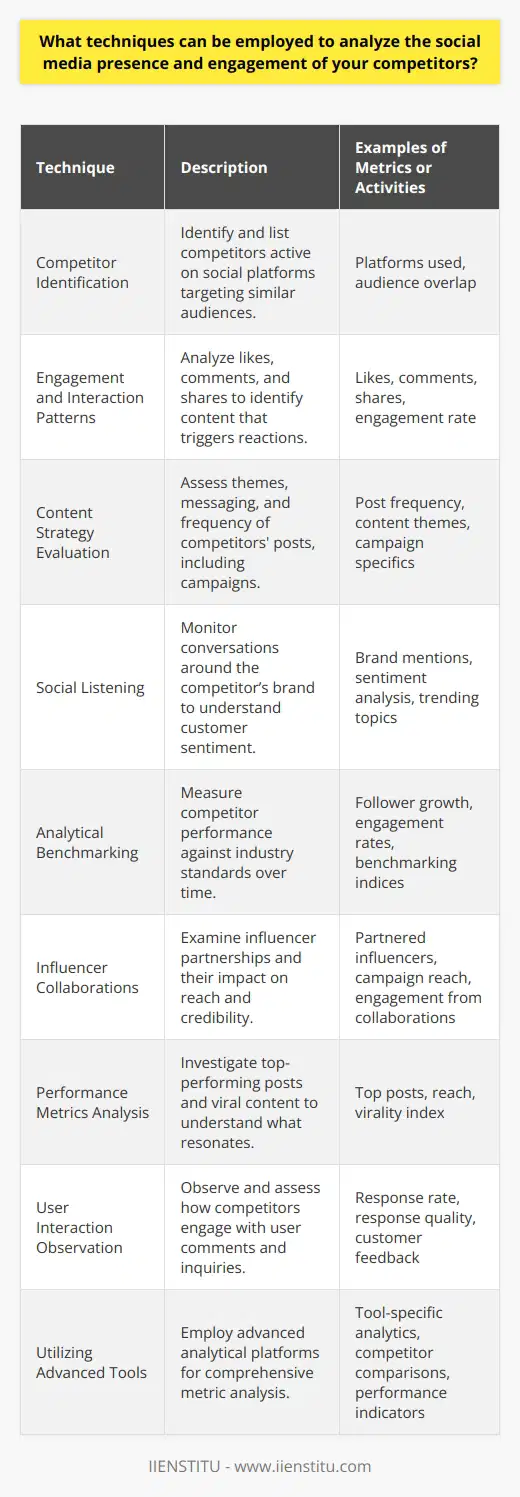
How can you effectively compare and contrast the digital marketing strategies of your competitors to identify areas of improvement for your own business?
Analyzing Competitors' Digital Marketing Strategies
To effectively compare and contrast the digital marketing strategies of your competitors, it is essential to begin by identifying the key components of a digital marketing strategy. These components include SEO practices, content marketing approach, social media engagement, and email marketing campaigns.
Examining SEO Approaches
Evaluate the search engine optimization (SEO) techniques employed by your competitors to understand how they rank better in search results. Assess their website's metadata, keyword usage, and backlink profile to identify potential areas for improvement in your own strategy.
Assessing Content Marketing Strategies
Compare and contrast the content marketing strategies employed by competing businesses, focusing on the quality, relevance, and accessibility of their content. Analyze the topics they cover, their publication frequency, and the tone of voice used to convey their messages. This assessment will help you determine which aspects of your own content strategy need refinement.
Evaluating Social Media Engagement
Consider your competitors' level of engagement on social media platforms by observing their posting frequency, the types of content they share, and the interactions they have with their followers. This analysis will help you identify ways to boost your own social media presence and boost customer engagement.
Scrutinizing Email Marketing Practices
Review the email marketing campaigns of your competition, paying special attention to the style, tone, and frequency of their communications. Pay attention to their segmentation strategies and the types of promotions they offer. This information will help you identify potential gaps in your own email marketing approach.
Benchmarking Performance Metrics
Finally, it is crucial to benchmark the performance metrics of your competitors' strategies to ensure that you are objectively analyzing their effectiveness. This comparison will require gathering data on metrics such as conversion rates, click-through rates, and website traffic, as well as analyzing their ROI.
In conclusion, comparing and contrasting the digital marketing strategies of your competitors requires careful analysis of their SEO practices, content marketing, social media engagement, email marketing campaigns, and performance metrics. The insights you gain from this process will not only help you identify areas in your own digital marketing approach that require improvement but also aid you in understanding the strengths and weaknesses of your competition. This knowledge will enable you to optimize your own digital marketing practices and ultimately enhance your business's online presence.
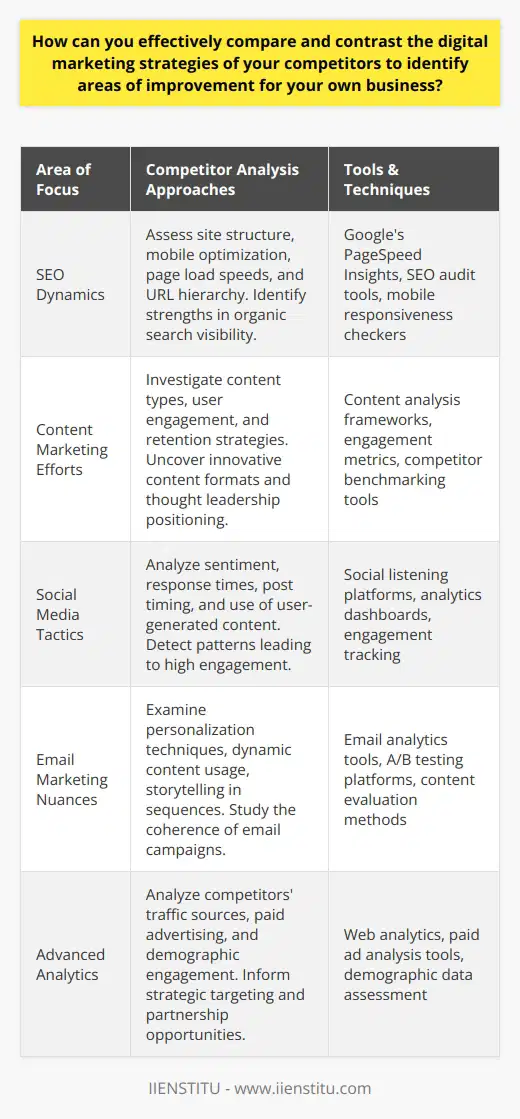
How can I utilize competitor analysis to improve my website's SEO and overall online presence?
Understanding the Competitive Landscape
To effectively utilize competitor analysis in improving a website's Search Engine Optimization (SEO) and overall online presence, it is crucial to comprehend the competitive landscape first. This means identifying direct and indirect competitors and analyzing their online performance, strategies, and tactics.
Analyzing Competitors' SEO Strategies
An in-depth analysis of competitors' SEO strategies can reveal valuable insights on the key factors to focus on. Some essential components to examine include the use of relevant keywords, content quality, backlink profile, architecture and user experience, and overall performance metrics.
Evaluating Keyword Strategies
Competitor analysis can help discover popular keywords in the niche, which can be used to create targeted and relevant content. Ensure to strike a balance between using high-ranking and long-tail keywords, keeping user intent and search volume in mind.
Assessing Content Quality
Comparing the content present on competitor websites can help identify patterns, trends, and gaps in coverage. To enhance content quality, focus on producing unique, engaging, and informative content that provides value to users and addresses their needs.
Improving Backlink Profile
Backlinks contribute significantly to a website's SEO and authority. Gain insights into competitors' backlink profiles, focusing on the number, quality, and diversity of backlinks. Generate high-quality content that encourages reputable websites to link back and increase overall domain authority.
Optimizing Website Architecture and User Experience
A well-structured website with good user experience (UX) will improve SEO rankings. Analyze competitor websites to identify best practices for site architecture and UX, such as mobile-friendliness, site speed, and clear navigation.
Monitoring Performance Metrics
Regularly track both your own and competitors' key performance metrics, such as organic traffic, bounce rate, and click-through rate. Use the collected data to make informed decisions and iterate strategies for continuous improvement.
Building a Social Media Presence
Social media platforms can significantly impact a website's online presence. Assess competitor social media strategies to identify best practices and opportunities for brand promotion, audience engagement, and content sharing.
In conclusion, conducting a thorough competitor analysis and leveraging the insights gained can lead to improvements in SEO and overall online presence. By tailoring strategies based on competitors' strengths and weaknesses, a website can achieve better visibility, attract more users, and enhance its credibility in the eyes of both search engines and visitors.
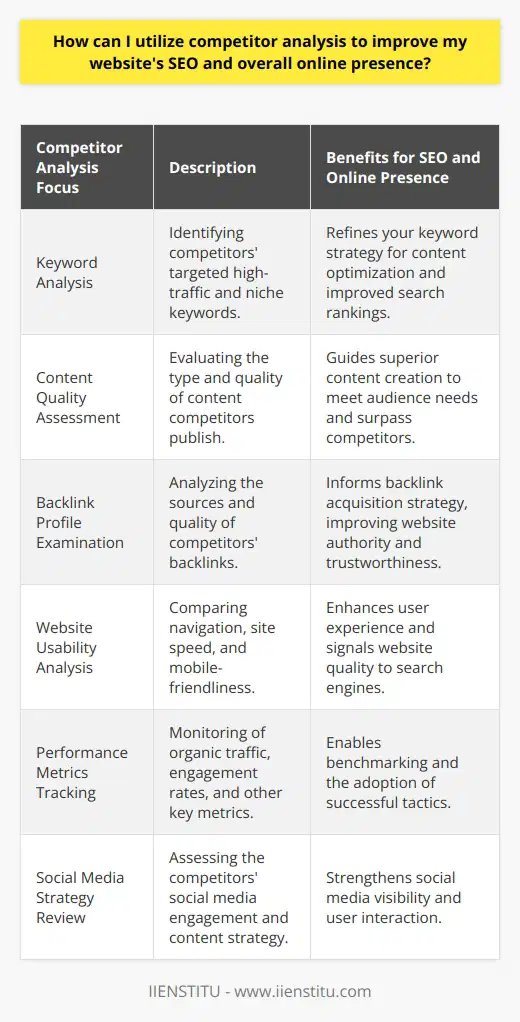
What strategies can be implemented to gain a competitive edge in search engine rankings after conducting a comprehensive competitor analysis?
Understanding Competitor Analysis
A comprehensive competitor analysis is crucial for gaining a competitive edge in search engine rankings. With proper understanding of competitors' strategies, one can devise a well-informed plan to outrank them.
Keyword Research and Optimization
One of the main strategies to gain an advantage in search engine rankings is focusing on keyword research. Identifying high-potential keywords related to the target audience's search queries, monitoring their performance, and incorporating them into content creation and optimization processes significantly increase the likelihood of achieving higher rankings.
Content Quality and Relevance
Creating high-quality, relevant, and engaging content is another vital strategy to outperform competitors. By providing well-researched and valuable information with a unique perspective, websites can naturally attract more organic traffic and improve their search engine rankings.
Responsive Web Design
To keep up with the growing focus on mobile browsing experience, implementing responsive web design is essential. Websites with a user-friendly interface, optimized for various devices and screen sizes, will gain favor with search engines and users, contributing to better rankings and higher traffic.
Link Building and Outreach
Establishing a strong network of authoritative and relevant backlinks can significantly improve website rankings and online visibility. Fostering relationships with industry influencers, creating share-worthy content, and participating in online communities contribute to attracting high-quality backlinks.
Social Media and Content Promotion
Social media plays a vital role in building brand awareness and driving traffic to a website. By actively promoting content on relevant social media platforms, engaging with the target audience, and participating in discussions, websites can increase their visibility and improve their chances of ranking higher in search engine results.
Technical SEO Optimization
Optimizing website infrastructure for search engine crawling, indexing, and rendering is crucial for achieving higher rankings. This includes addressing site speed, rendering issues, navigation problems, and avoiding usage of technologies that impede search engine accessibility.
Monitoring and Adjustments
To maintain the competitive edge, continuous monitoring of website performance and competitor activities is essential. Utilizing advanced analytics tools and adjusting strategies based on data-driven insights can provide the necessary feedback for adapting and keeping up with the evolving search engine algorithms.
In conclusion, conducting a comprehensive competitor analysis allows the identification and implementation of various strategies to gain a competitive edge. By focusing on keyword research, providing high-quality content, prioritizing responsive web design, building authoritative backlinks, leveraging social media, optimizing technical SEO, and monitoring performance, websites can significantly improve their chances of ranking higher than competitors in search engine results.

How can you effectively measure and track the impact of your SEO efforts in comparison to your competitors?
Monitoring Key Performance Indicators
To effectively measure and track the impact of your SEO efforts in comparison to your competitors, monitoring specific key performance indicators (KPIs) is crucial. KPIs enable you to analyze your website's performance and recognize areas that require improvement. Some crucial KPIs to track when comparing your SEO efforts to your competitors include organic search traffic, keyword rankings, and backlinks.
Tracking Organic Search Traffic
Organic search traffic refers to the number of users who visit your website through search engine result pages (SERPs) without any paid advertisements. Monitoring this metric allows you to assess the success of your SEO strategies in driving users to your site. Google Analytics is a valuable tool for tracking organic search traffic, as it allows comparison of your website's performance against your competitors. By analyzing the percentage of traffic driven by organic searches, you gain insights about your strategies' effectiveness and compare it with your competitors.
Analyzing Keyword Rankings
Keyword rankings represent your website's position in SERPs for specific search terms. Comparing keyword rankings between your website and your competitors' enables you to recognize which keywords generate the most organic traffic for both parties. To track your keyword rankings effectively, use tools such as SEMRush or Ahrefs, which allow comparative analysis of your target keywords' rankings and those of your competitors. This information can guide your efforts in improving your website's keyword optimization and outperforming your competition.
Assessing Backlinks
Finally, backlinks are external websites that link to your site, serving as a vital component of SEO since they signify trust and credibility. A higher number of high-quality backlinks usually results in better search rankings. To measure the impact of your link-building efforts, analyze your backlink profile and compare it to your competitors'. Tools such as Moz's Link Explorer and Ahrefs' Site Explorer assist in tracking your backlinks, revealing the domains that link to your site and the type of content they link to. By comparing your backlink profile with your competitors, you identify potential link-building opportunities and evaluate the success of your current efforts.
In conclusion, tracking key performance indicators like organic search traffic, keyword rankings, and backlinks is essential for measuring and comparing the impact of your SEO efforts with your competitors. Utilizing these metrics and the available tools will enhance your understanding of your current SEO strategies' effectiveness and help identify areas where improvement is necessary. By continuously evaluating your performance against your competitors, you will develop more productive SEO strategies and achieve better results in search rankings.
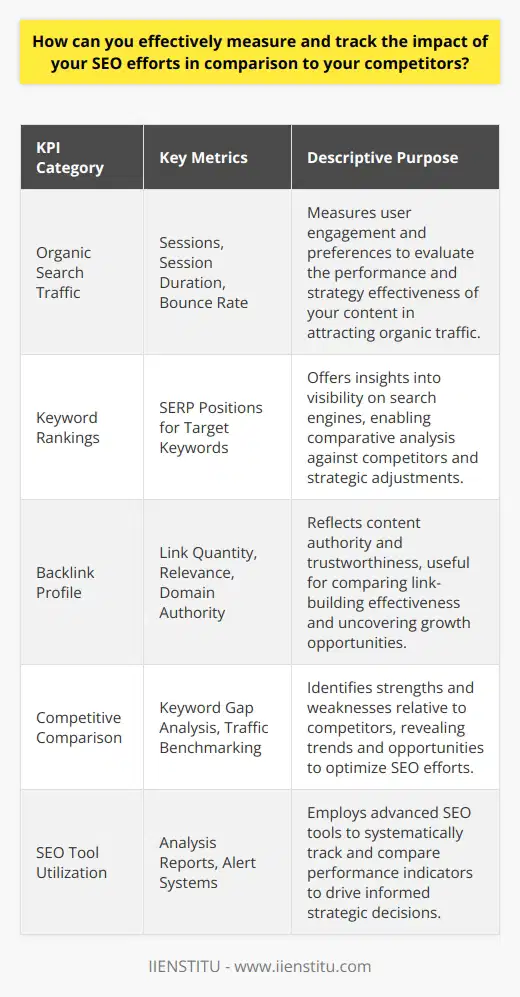
How can I analyze my competitors' on-page SEO elements and overall site structure?
Identify Competitors' On-Page SEO Elements
To analyze competitors' on-page SEO elements and overall site structure, begin with keyword research that will allow you to discover the terms commonly used by your audience. Use SEO tools such as Ahrefs, Moz, or SEMrush to identify the primary keywords driving organic traffic to your competitors' sites. With this data, you can compare your own keyword usage to that of your competitors and devise a strategy for optimizing your content.
Assess Competitors' Site Structure
Examine their site structure by analyzing their navigation menus, URL structures, and use of internal linking strategies. This will provide insight into how they guide users and search engines towards relevant content. To visualize their site's organization, create a map or schematic representation that displays the hierarchy and interconnectivity of their pages.
Review On-Page SEO Elements
Carefully review the on-page SEO elements, such as title tags, meta descriptions, header tags, and image alt text on your competitors' sites. These elements play a crucial role in helping search engines understand the content and intent of each page. Analyze how your competitors employ these elements effectively and apply this information to your own on-page SEO strategy.
Investigate Website Speed and Mobile-Friendliness
As user experience is an important factor for search rankings, assess your competitors' website speed by using tools like Google's PageSpeed Insights or GTmetrix. Faster loading times contribute to better user experience and can provide a competitive edge in SEO efforts. Additionally, examine their mobile-friendliness by utilizing resources like Google's Mobile-Friendly Test to determine if their site is optimized for mobile users.
Study Backlink Profiles
Backlinks play a vital role in improving organic search rankings. Investigate the backlink profiles of your competitors using SEO tools to uncover which websites link to their content, along with the quality and relevance of those links. This information will help you determine which sites might be valuable for establishing your own backlinks and creating collaborative relationships.
Analyze User Engagement Metrics
Finally, explore user engagement metrics to gauge the effectiveness of your competitors' on-site content. Analyze metrics such as time on site, bounce rate, and pages per session to get an idea of how engaging the content is for users. This information may reveal opportunities to improve your site's content and user experience, thereby enhancing your SEO performance.
In conclusion, by analyzing competitors' on-page SEO elements and overall site structure, you can acquire valuable insights into their strengths, weaknesses, and opportunities for your site. By implementing these techniques, you can improve your content strategy and SEO efforts, resulting in higher search engine visibility and increased organic traffic.

What tools and resources are available for conducting a thorough SEO competitor analysis without incurring additional costs?
Free SEO Tools and Resources
Effective SEO competitor analysis can be conducted utilizing various free tools and resources without incurring additional costs. One fundamental resource is Google Analytics, which helps track a competitor's organic search traffic, identify their top-performing keywords, and provides comparative performance insights. Another useful tool is Google Search Console, enabling users to monitor website traffic, optimize content, and resolve site errors.
Keyword Analysis Tools
Keyword analysis is a critical aspect of SEO competitor analysis, and free resources such as Ubersuggest and Google Trends can provide valuable insights. Ubersuggest provides keyword suggestions, difficulty scores, and search volume, while Google Trends helps users track keyword popularity over time. These tools can help identify gaps and lucrative opportunities in a competitor's keyword strategy.
Backlink Analysis Tools
Understanding the backlink profile of a competitor is essential for developing effective link-building strategies. Free resources such as Backlink Checker and OpenLinkProfiler can assist in exploring competitor backlinks. These tools can reveal the total number of backlinks, referring domains, and anchor text distribution, providing insights into a competitor's link-building strategies and potential collaboration opportunities.
Content Analysis Tools
Analyzing a competitor's content can determine the effectiveness of their content strategy and identify possible improvements. Readable.io is a free tool that evaluates the readability of a competitor's content, scoring it based on various factors, including sentence structure and word-choice complexity. Additionally, BuzzSumo is a resource that helps identify the most shared content articles within a specific topic or competitor’s domain.
On-Page SEO Analysis Tools
On-page SEO factors, such as metadata and content optimization, significantly impact search engine rankings. Tools like MozBar and SEO Site Checkup offer free on-page SEO audits, revealing crucial data about a competitor's on-page SEO technique. These audits can provide information about title tags, meta descriptions, and keyword usage in HTML headers, allowing users to optimize their sites accordingly.
Accessibility and Performance Analysis Tools
Assessing a competitor's website usability and performance is crucial in understanding the overall effectiveness of their online presence. Google's Mobile-Friendly Test and PageSpeed Insights tools allow users to gauge a competitor's site performance on mobile devices and analyze site speed. These tools can highlight potential weaknesses, such as slow-loading pages and lacking mobile optimization, which can be capitalized on to gain a competitive edge.
In conclusion, a variety of free tools and resources are available to conduct an in-depth SEO competitor analysis. By employing these resources to analyze competitors' keywords, backlinks, content, on-page optimizations, and website performance, businesses can gain valuable insights to inform their SEO strategy and outperform their competition.

How can I leverage the findings of a comprehensive SEO competitor analysis to develop and refine my own search engine optimization strategy?
Understanding the Competition
A comprehensive SEO competitor analysis provides valuable insights into the competition's strengths and weaknesses, helping to develop and refine one's own SEO strategy. By examining the top-performing competitors, one can identify their most successful tactics and emulate them to gain a competitive advantage in the search engine results.
Keyword Opportunities
One crucial aspect of an SEO competitor analysis is identifying keyword opportunities. Analyzing the keywords for which competitors rank will reveal gaps that can be filled by developing content around under-emphasized keywords or long-tail phrases. Additionally, understanding the competition's keyword strategy can help to optimize existing content for improved search visibility by incorporating popular, relevant, and less competitive keywords.
Content Quality and Relevance
Another area in which to leverage competitor analysis is content quality and relevance. Examining high-ranking competitor content can provide inspiration for creating original pieces that offer unique perspectives on popular topics or delve deeper into niche areas. Furthermore, analyzing competitor content enables one to identify common themes and trends, allowing for the creation of relevant and timely content that appeals to the target audience.
Site Structure Optimization
A well-organized website with intuitive navigation is essential for a successful online presence. By examining the website structures of top-performing competitors, one can identify best practices to implement and any areas in which they may fall short. Building a robust, user-friendly site structure can improve both search visibility and user engagement, increasing the likelihood of conversion.
Link Building Strategies
Lastly, a comprehensive SEO competitor analysis will reveal valuable information about their link-building strategies. Understanding the type and authority of sites linking to one's competition can help identify potential link-building opportunities. Furthermore, it can highlight any weaknesses in their backlink profile, presenting a chance to take advantage of these gaps and improve one's own domain authority and search rank.
In conclusion, conducting a comprehensive SEO competitor analysis can offer significant insight into the successful strategies employed by top-ranking competitors. Leveraging such findings allows for the development and refining of one's own search engine optimization strategy, ultimately leading to improved search visibility and a competitive edge in the digital landscape.
